Click To Call > (800) 966-7673

Stinging insects include bees, wasps, yellowjackets and hornets, all belonging to the order of insects known as Hymenoptera, which also includes ants. Most stinging insects are considered beneficial pollinators as long as they are not posing a threat to people or property. It's important to properly identify the type of stinging insects you have to determine if they are aggressive and the best way to remove them.
In Michigan, Ohio, and Indiana the most common stinging insects are paper wasps, yellowjackets, bald-faced hornets, honeybees, and carpenter bees. While people in our area commonly refer to stinging insects as hornets, we do not have hornets in our region. The bald-faced hornet is actually a yellowjacket.
The two easiest ways to identify the type of stinging insect you have:
Medium level of aggression, generally won’t cause any problems unless close contact is made with the nest or an individual wasp has been touched.
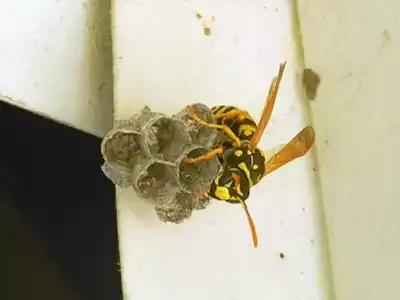
Nest: Smaller in size, greyish, round in shape, with a distinctive honeycomb pattern. Usually found under eaves, under overhangs, and on fences.
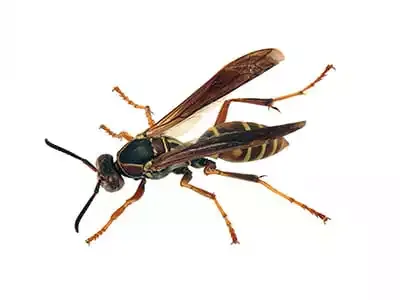
Appearance: We commonly encounter two different species, the European Paper Wasp is striped yellow and black with orange antennae (resembles yellowjackets, but is larger, with long hind legs that can be seen dangling while in flight). The other common species called the Northern Paper Wasp has a brown body with dark orange areas, and thin yellow or white stripes on the abdomen.
High level of aggression, especially in late Summer and Fall as the colony reaches its largest size.
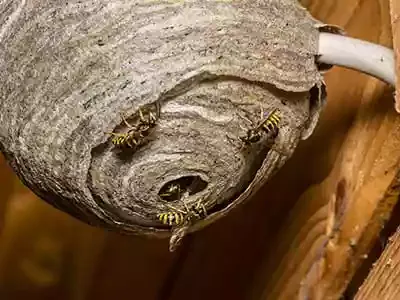
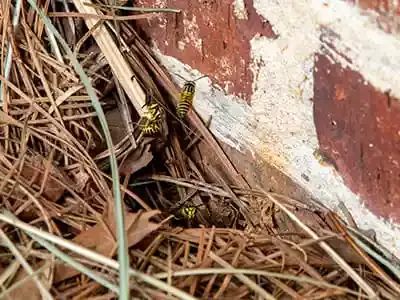
Nest: Larger nests with more individuals (hundreds to thousands) usually covered with a gray and black colored paper-like material. Found inside places like attics, under porches and in dense bushes. Some common species prefer to nest in the ground.
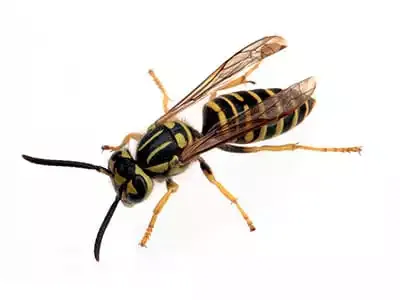
Appearance: Black and yellow stripes on the abdomen, head with black antennae. They are fast flyers with legs tucked against the body in flight.
High level of aggression, especially in late Summer and Fall as the colony reaches its largest size.
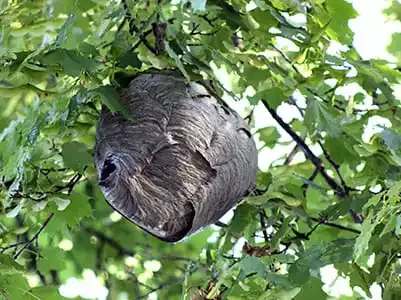
Nest: Larger nests with more individuals. Nests resemble a large, inverted tear-drop shaped ball. Typically attached to a tree, bush, side of a building or undisturbed tall grass.
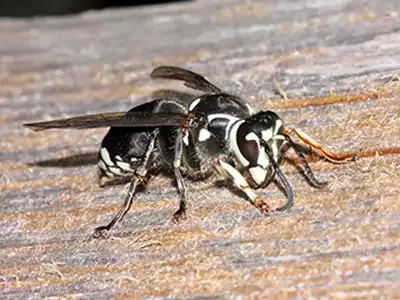
Appearance: Black and white smooth body made up of slightly larger head, thorax, and abdomen with a stinger.
Low to medium aggression in our region. Some strains have been bred for gentleness and are as close to sweethearts as stinging insects can get! More information on differentiating bees from wasps.
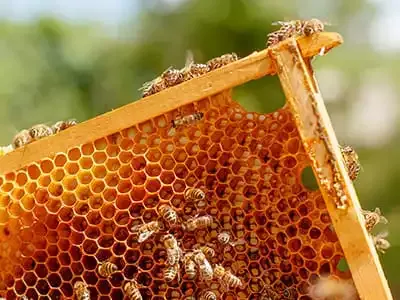
Nest: Hives are extensive combs made of wax and are found in wall cavities, hollow trees, and rock crevices. Round in shape and resembling a honeycomb pattern. Unlike other stinging insects in our region honeybee colonies can last for numerous consecutive years, which is why they store up honey, so they have food for the winter.
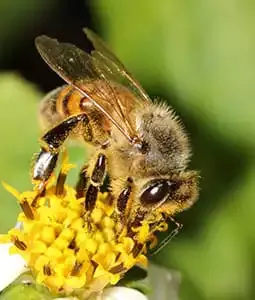
Appearance: Orange/Yellowish and brown fuzzy body made up of head, thorax, and abdomen with a stinger.
Low aggression, even when the nest is approached.
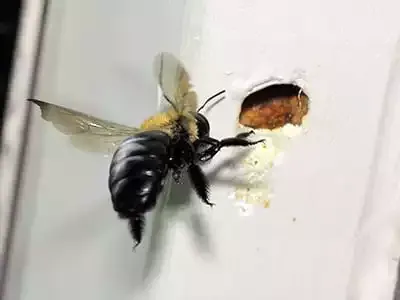
Nest: Bores perfectly round 3/8” holes in wood siding, fascia, and decks in the Spring. The wood isn’t eaten but thrown out of the opening, so the hollow cavity can be used for rearing young.
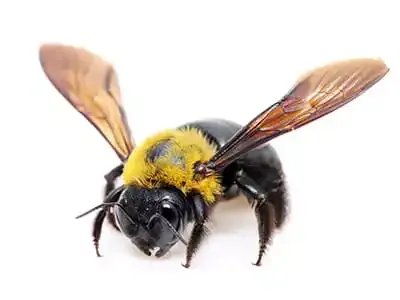
Appearance: Large bees that resemble bumblebees. The one species in our region has a yellow and black fuzzy thorax, with a shiny (hairless) black abdomen. Males have a yellow spot on their face and are easy to distinguish.
Stinging insects can be dangerous however, not all stinging insects are aggressive and the majority of them won't sting unless provoked to defend their nest. No males of any species are capable of stinging. A good rule of thumb to remember is the larger (more workers) a stinging insect colony is, the more aggressive they are. Solitary species or foraging individuals tend to not sting unless touched. Wasps and yellowjackets generally will not sting unless you wander too close to their nest. If they perceive you as a threat they will attack to defend their nest. Ground nests can often be difficult to see until it's too late. Yellowjackets can pose a considerable threat to humans as they may sting repeatedly, stings are painful and can cause allergic reactions and anaphylactic shock in severe cases.
Stinging insects are opportunistic builders and are always in search of ideal nesting conditions.
Getting rid of wasps and yellowjackets can be a very dangerous undertaking best left to professionals. There are many DIY sprays on the market that may temporarily reduce stinging insect activity but will not kill all of the insects in the nest and will almost certainly provoke an attack. If you really want to give it a try we suggest waiting until after dark to treat the nest, when all workers will be inside and it will be least active. Our service technicians are highly trained to identify the type of stinging insect you have, locate the nest and any nearby nests, and determine the safest and most efficient way to permanently eliminate the nests.
Rose Pest Solutions is a leader in the field of pest control and uses the most up-to-date pest control methods available. Every pest control product we use has been registered by the EPA and conforms to the strictest guidelines. This means that you can have peace of mind knowing that no Rose Pest Solutions treatment will pose any threat to people, pets or plants. Should it be necessary, our service technicians will inform you of any product-specific safety measures that are required.
Factors that we have to consider before we can quote stinging insect extermination include:
We understand that having stinging insects in or around your home is an urgent matter. Contact your nearest Rose Pest Solutions service center immediately for an appointment. In many cases, we can respond within 24-48 hours.
Because of the random, opportunistic nature of nest building with wasps and yellowjackets, it is difficult to prevent a nest being built on or around your property unless you know what you are looking for. That's why we offer our home service program. For one low annual fee, your technician will come out three times a year to inspect your home for signs of potential pest problems like stinging insects, rodents and ants. If treatment is required for common pests, it's covered under your annual fee. It's protection and peace of mind for you and your family. Do you have wasps or yellowjackets? Find more information here.

The Rose Home Service Program offers regularly scheduled pest control services for a single annual price, designed to identify and prevent infestations of the most common pests. Whether you're dealing with ants, spiders, or other common invaders, our Home Service Programs provide year-round protection and peace of mind.